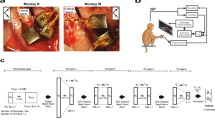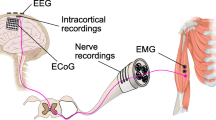Abstract
The problem of neural decoding is essential for the realization of a neural interface. In this study, the position of the moving finger of a macaque was directly decoded through the neuron spike signals in the motor cortex, instead of relying on the synergy of the related muscle tissues around the body, also known as neural decoding. Currently, supervised learning is the most commonly employed method for this purpose. However, based on existing technologies, unsupervised learning with regression causes excessive errors. To solve this problem, weakly supervised learning (WSL) was used to correct the predicted position of the moving finger of a macaque in unsupervised training. Then, the corrected finger position was further used to train and accurately fit the weight parameters. We then utilized public data to evaluate the decoding performance of the Kalman filter (KF) and the expectation maximization (EM) algorithms in the WSL model. Unlike in previous methods, in WSL, the only available information is that the finger has moved to four areas in the plane, instead of the actual track value. When compared to the supervised models, the WSL decoding performance only differs by approximately 0.4%. This result improves by 41.3% relative to unsupervised models in the two-dimensional plane. The investigated approach overcomes the instability and inaccuracy of unsupervised learning. What’s more, the method in the paper also verified that the unsupervised encoding and decoding technology of neuronal signals is related to the range of external activities, rather than having a priori specific location.









Similar content being viewed by others
References
Kim KT, Suk HI, Lee SW. Commanding a brain-controlled wheelchair using steady-state somatosensory evoked potentials. IEEE Transactions on Neural Systems and Rehabilitation Engineering. 2018;26:654–65.
Caporusso N. Issues, challenges and practices in advancing pervasive human-computer interaction for people with combined hearing and vision impairments. Ph.D. dissertation, Computer Science and Engineering, IMT Institute for Advanced Studies, Lucca, Italy; 2012.
Jacobo FV, Chu LY, Kahori K, Yu W. 3D continuous hand motion reconstruction from dual EEG and EMG recordings. In: Proceedings of International Conference of Intelligent Informatics and Biomedical Sciences (ICIIBMS); Okinawa, Japan, 2015. p. 28-30.
Fan JJ, Tian F, Du Y, Liu ZJ, Dai GZ. Thoughts on human-computer interaction in the age of artificial intelligence. Scientia Sinica Informationis. 2018;48:361–75.
Tian L, Zimmerman B, Akhtar A, et al. Publisher Correction: Large-area MRI-compatible epidermal electronic interfaces for prosthetic control and cognitive monitoring. Nature Biomedical Engineering. 2019;3(3):194–205. https://doi.org/10.1038/s41551-019-0347-x.
Borra E, Gerbella M, Rozzi S, Luppino G. The macaque lateral grasping network: a neural substrate for generating purposeful hand actions. Neuroscience and Biobehavioral Reviews. 2017;75:65–90.
Philippsen A, Nagai Y. A predictive coding model of representational drawing in human children and chimpanzees. In: Proceedings of 2019 Joint IEEE 9th International Conference on Development and Learning and Epigenetic Robotics (ICDL-EpiRob), Oslo, Norway, 2019. p. 171-176.
Georgopoulos AP, Lurito JT, Petrides M, Schwartz AB, Massey JT. Mental rotation of the neuronal population vector. Science. 1989;243:234–6.
Chen Z, Takahashi K. Sparse Bayesian inference methods for decoding 3D reach and grasp kinematics and joint angles with primary motor cortical ensembles. In: Proceedings of Engineering in Medicine and Biology Society (EMBC), 2013 35th Annual International Conference of the IEEE, Osaka, Japan, 2013. p. 3-7.
Haykin S. Neural networks and learning machines. 3rd ed. Prentice Hall: Upper Saddle River, NJ; 2008.
Czanner G, Eden UT, Wirth S, Yanike M, Suzuki WA, Brown EN. Analysis of between-trial and within-trial neural spiking dynamics. Journal of Neurophysiology. 2018;99:2672–93.
Aghagolzadeh M, Truccolo W. Latent state-space models for neural decoding. In: Proceedings of 36th Annual International Conference of the IEEE Engineering in Medicine and Biology Society (EMBC), Chicago, USA. 2014. P. 3033-3036.
Rule ME, Sanguinetti G. Autoregressive point-processes as latent state-space models: a moment-closure approach to fluctuations and autocorrelations. Neural Computation. 2018;30:2757–80.
Syed AM, Gunasekaran N, Esther RM. Robust stability of hopfield delayed neural networks via an augmented L-K functional. Neurocomputing. 2017;234:198–204.
Paranjape PN, Dhabu MM, Deshpande PS, Kekre AM. Cross-correlation aided ensemble of classifiers for BCI oriented EEG study. IEEE Access. 2019;7:11985–96.
Li SK, Jiang YB. Semi-supervised sentiment classification based on sentiment feature clustering. Journal of Computer Research and Development. 2013;50:2570–7.
Xue ML, Wu HF, Zeng Y. Unsupervised CKF decoding for macaque motor cortical spikes. Acta Automatica Sinica. 2017;43:302–12.
Zhou ZH. A brief introduction to weakly supervised learning. National Science Review. 2018;5:44–53.
Zhang XD. Modern signal processing. 3rd ed. Beijing, China: Tsinghua University Press; 2015.
Wu HF, Feng JY, Zeng Y. Neural decoding for macaque’s finger position convolutional space model. IEEE Transactions on Neural Systems and Rehabilitation Engineering. 2019;27:543–51.
Smith AC, Frank LM, Wirth S, Yanike M. Dynamic analysis of learning in behavioral experiments. Journal of Neuroscience. 2004;24:447–61.
Wallisch P, Lusignan ME, Benayoun MD, Baker TL, Dickey AS, Hatsopoulos NG. Matlab for neuroscientists. 2nd ed. London: Academic Press; 2014.
Raschka S. Python machine learning. 2nd ed. Birmingham, UK: Packt Publishing; 2015.
Acknowledgements
This work was supported in part by the National Natural Science Foundation of China (No. 61762093), the 17th batches of Young and Middle-aged Leaders in Academic and Technical Reserved Talents Project of Yunnan Province (No. 2014HB019), the Key Applied and Basic Research Foundation of Yunnan Province (No. 2018FA036), the Program for Innovative Research Team (in Science and Technology) in University of Yunnan Province, and the Science Research Fund Program in Education Department of Yunnan Province (No. 2018Y106).
Author information
Authors and Affiliations
Corresponding author
Ethics declarations
Conflict of interest
The authors declare that they have no conflict of interest.
Ethical approval
All applicable international, national, and/or institutional guidelines for the care and use of animals were followed.
Informed consent
This work is informed consent by any of the authors.
Additional information
Publisher’s Note
Springer Nature remains neutral with regard to jurisdictional claims in published maps and institutional affiliations.
Rights and permissions
About this article
Cite this article
Feng, J., Wu, H., Zeng, Y. et al. Weakly supervised learning in neural encoding for the position of the moving finger of a macaque. Cogn Comput 12, 1083–1096 (2020). https://doi.org/10.1007/s12559-020-09742-4
Received:
Accepted:
Published:
Issue Date:
DOI: https://doi.org/10.1007/s12559-020-09742-4




